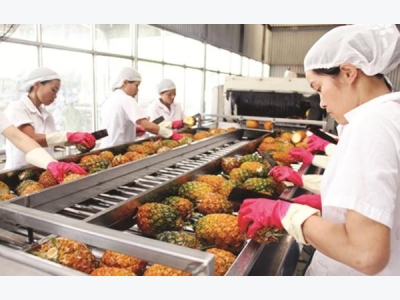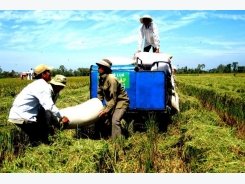Opportunity to expand the market for Vietnamese vegetables and fruits

According to the latest statistics of the General Department of Customs, as of April 30, the total value of fruits and vegetables exports of our country has reached 1.02 billion USD, up by nearly 33% over the same period year in 2016.
There was an impressive breakthrough of vegetables and fruits export in the recent period. Photo: the internet.
Thus, in average, vegetables brought about $ 8.5 million every day, equivalent to the amount of more than 192 billion VND per day. Along with the UAE's enactment of a ban on the import of vegetables and fruits from five Middle Eastern countries, it is opening up great opportunities for Vietnamese fruit and vegetable enterprises to take advantage and increase export.
Great potential
According to the report of the Ministry of Agriculture and Rural Development, agricultural export turnover in April reached $2.9 billion which made this figure of the first four months of 2017 up to USD 10.8 billion, increased by 9,1% in comparison with the same period of 2016. Of which, the export value of fruit and vegetables in the first four months is estimated at $313 million, the export volume of these four months is estimated at $1 billion, increased by 32.6% over the same period of 2016. In the first three months of the year, the market with a sharp increase for vegetables is UEA, which raise by 2.04 times, Russia (88.7%), Japan (50.9%),...
With the above result, vegetables and fruits continue to maintain their position as the third largest exporter of agricultural and aquatic products in Vietnam (after seafood and coffee). Notably, fruit and vegetable products grew faster than seafood (only 7.8%) and coffee (21%).
China, United States, Japan and South Korea were the top four importers of Vietnamese fruit and vegetable products in the first quarter, accounting for 82.9 percent of total fruit and vegetable exports. Particularly, the value of vegetables which exported to China reached USD 512 million, accounting for 73% of the total export turnover of this commodity at the same period last year.
According to Mr. Bui Sy Doanh, deputy head of the Plant Protection Department (under MARD), Australia has published its final report on the assessment of the biological safety requirements for Vietnamese dragon fruit in early January 2017. Accordingly, the functional authorities of Australia and Vietnam will take the final step to set the standard operating process for the facilities which use water steam for dragon fruit processing and complete the import conditions for Vietnamese dragon fruit. There are many importers from the US, Japan, Korea ... have come to Vietnam to find suppliers.
Mr. Nguyen Van Ky, general secretary of Vietnam Vegetables & Fruits Association (VINAFRUIT) said that vegetables and fruits are becoming the bright spot in agricultural exports as they continue to maintain rapid growth momentum and have plenty of room to grow in. next time. In terms of export markets, according to Mr. Ky, by now, Vietnamese vegetables and fruits have been exported to 40 markets in the world, of which 10 major export markets are China, Japan, USA, Russia and Taiwan. China, Korea, Indonesia, Netherlands, Thailand and Singapore. Besides the traditional markets, Vietnam is now expanding to new markets, although fastidious but high export value expectation, such as Australia has now allowed import of Thieu litchi, longan and Dragon fruit in the incoming time; New Zealand has opened its doors for mango and dragon fruit, the next is rambutan; India (dragon fruit, breast milk), Chile (dragon fruit) ...
A wide-opened door to UAE
Recently, the United Arab Emirates Ministry of Climate Change and Environment (MOCCAE) has issued a ban on the import of some fruits and vegetable products from five Middle Eastern countries, including Egypt, Oman, Jordan, Lebanon and Yemen due to excess pesticide residues. This ban came into effect on May 15, 2017, to protect the health of UAE consumers. Accordingly, the vegetables are prohibited fruit imports include: bell peppers from Egypt; Cabbage, lettuce, pumpkin, beans and eggplant from Jordan; Apples from Lebanon; Melons, carrots and watercress from Oman; And all kinds of fruits from Yemen.
This is considered a great opportunity for Vietnamese fruit and vegetable enterprises to increase exports and expand markets. According to statistics of Vietnam Customs, fruit and vegetable exports to the UAE just reached $14.2 million in 2014, $16.2 million in 2015 and $ 22.8 million in 2016, although this figure is steadily growing but the export turnover of Vietnam still accounts for a negligible share in total import value of this product of UAE. However, in order to gain access to the UAE market and increase the export value, Vietnamese fruit and vegetable exporters should pay attention to the UAE food safety standards, especially with pesticide residues.
Dr Nguyen Huu Dat, Member of the Executive Board of the Vietnam Fruit and Vegetable Association (VINAFRUIT), said that the global demand for fruit and vegetable products continues to increase as the opportunity for export growth for this product of our country in present as well as the incoming time. "In the past two years, there has been a close connection between the export enterprises, farmers and the producers, thus, the quality and design of the products has been improved, creating a stable product resource, thereby increasing the prestige of Vietnam vegetables and fruits on the world market "- Mr. Dat said.
Related news
Tools

Phối trộn thức ăn chăn nuôi

Pha dung dịch thủy canh

Định mức cho tôm ăn

Phối trộn phân bón NPK

Xác định tỷ lệ tôm sống

Chuyển đổi đơn vị phân bón

Xác định công suất sục khí

Chuyển đổi đơn vị tôm

Tính diện tích nhà kính

Tính thể tích ao



 Vietnam vows to reorganize coffee production
Vietnam vows to reorganize coffee production  Vietnamese fruit exporters warned about 13 UAE companies
Vietnamese fruit exporters warned about 13 UAE companies